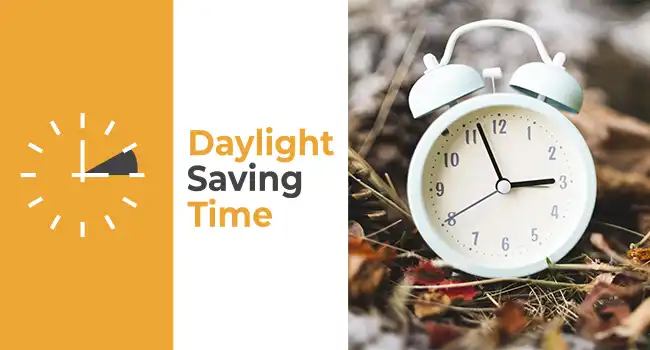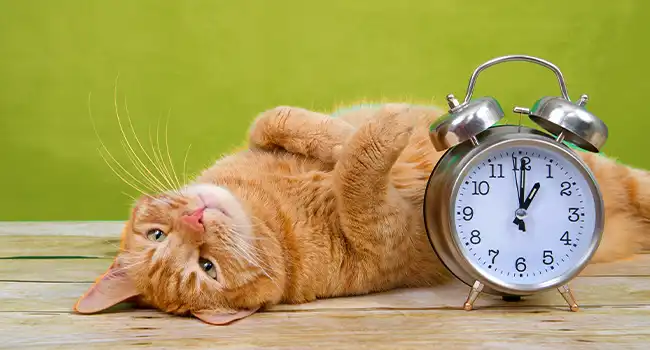When does Daylight Saving Time end? Here is everything you need to know:
When Will We “Fall Back” In 2025?
Daylight Saving Time 2025 ends on the first Sunday in November. We “fall back” one hour and return to Standard Time on Sunday, November 2, 2025 at 2 a.m. (2 a.m. on this date becomes 1 a.m.) Be sure to set your clocks back one hour before bed Saturday night!
The return of standard time means the Sun will rise a little earlier according to your clock. If you’re an early riser, you’ll enjoy more natural light with your breakfast. You’ll also “gain” one more hour of sleep. The bad news? It will be dark by the time most of us get out of work.
When Will We “Spring Forward” In 2026?
Daylight Saving Time 2026 begins on the second Sunday in March in most areas of the US. In 2026, we will “spring forward” one hour on Sunday, March 8, 2026. At 2 a.m. on this date, the time will spring forward to become 3 a.m.
Who Doesn’t Observe Daylight Saving Time 2025?
According to United States law, states can choose whether or not to observe DST. At present, Arizona (with the exception of the Navajo Nation) and Hawaii, plus a few other US territories, are the only places in the US that do not observe Daylight Saving Time and stay on standard time all year long.

Indiana did not vote to observe DST until April 2006. Prior to that, some counties in the state observed it while others didn’t, which caused a lot of confusion, particularly since Indiana is split into two time zones already!
At least 40 countries worldwide observe Daylight Saving Time, including most of Canada, though the majority of Saskatchewan and parts of northeastern British Columbia don’t participate.
European Daylight Saving Time
Ireland, England, and the European Union observe Daylight Saving Time on a slightly different schedule, known as British Summer Time (BST). British Summer Time begins on the last Sunday in March and ends on the last Sunday in October.
This means that for a few weeks in the spring and fall the time difference between the United States and Europe is one hour different than usual.
Southern Hemisphere Daylight Saving Time
While most countries near the equator don’t deviate from standard time, those in the Southern Hemisphere such as Australia (certain states and territories) and New Zealand turn their clocks in the opposite way as the United States (to reflect their opposite seasons. For example: When it’s summer in the Northern Hemisphere, it’s winter in the Southern Hemisphere). Similar to British Summer Time, the exact time schedule varies for Southern Hemisphere locations.
Any questions? Let us know in the comments!
Are You Saying it Correctly?
The correct phrasing is “Daylight Saving Time” (not “Daylight Savings Time” with an “s”), meaning a time for saving daylight!
Is There A Benefit to DST?
The idea behind moving the clocks twice a year is to take advantage of the Sun’s natural electricity (or light). When we spring forward, we’re not really “saving” time; we’re just giving up a little Sun in the morning and adding it to the evening.
How you feel about Daylight Saving Time probably depends on whether you are an early riser or a night owl. Obviously, changing the number on a clock doesn’t actually add any time to our days. That point was eloquently made in this old joke:
When told the reason for daylight saving time the old Native American man said,
“Only the government would believe that you could cut a foot off the top of a blanket, sew it to the bottom, and have a longer blanket.“
However, in the spring, adding an hour of daylight onto the end of the day, after most of us have gotten out of work, can feel like a gift after a long winter of dark evenings. As the warmer spring weather arrives, nothing could be nicer than having more time in the evening to enjoy it!
Daylight Saving Time History And New Developments
Since Daylight Saving Time was introduced, lawmakers have, on occasion, seen fit to fiddle with it. This happened in the 70s, during the oil crisis, and again several years ago. In 2007, Daylight Saving Time became longer, beginning in March and ending in November, instead of April and October, respectively.
The latest: On March 15, 2022, the US Senate passed a bill to make Daylight Saving Time permanent. But the bill does not become law until the House of Representatives votes and the President signs the bill. Discussions have not taken place yet.
If the bill is signed into law, this would mean that this November will be the last time clocks will “fall back.” In March 2025, when we spring forward, the clocks won’t change from year to year.
Read details about your state’s current status via the National Conference of State Legislature.
What would permanent Daylight Saving Time mean for Our health and well-being?
On the bright side, the Sun won’t set so early on winter evenings. But this also means that the Sun will rise later in the morning, (around 8 a.m. for most Northern states during the winter months).
Some people are concerned that dark mornings will make commutes to work and school more difficult—especially for kids being picked up by buses. Others say that a permanent Daylight Saving Time shift may make it harder to fall asleep at night and hinder our ability to function during the day.
When the Sun rises, its light activates important hormones in our body that help us be active, calm, and focused. When the Sun sets, darkness releases a different hormone—melatonin—which helps us go to sleep.
Scientist and sleep medicine practitioner Dr. Kin Yuen suggests that permanent Daylight Saving Time may cause increased metabolic issues (diabetes, hypoglycemia, and weight gain) as well as greater fatalities. Learn more from the video below:
Is Benjamin Franklin To Blame For Daylight Saving Time?

Ben Franklin is often credited for inventing the idea of Daylight Saving Time, due to his partially tongue-in-cheek letter to a newspaper in Paris. Read his letter, via The Franklin Institute.
However, Franklin seemed to understand the point of view of the Native American in the joke, above. Rather than changing the clocks, he simply advised us to change our personal schedules to align better with nature.
Join the Discussion
What do you think about Daylight Saving Time?
If it were up to you, would you get rid of it?
Please share your feelings in the comments.


I have wanted to get rid of the twice yearly time change for many years now. It is a documented fact that the practice screws with our metabolism to such an extent that more heart attacks occur on the Monday after the time change than at any other time. I think we all feel jet-lagged by the time change every year, and yet we persist in this madness. Personally, I would prefer standard time (seriously, mankind has survived on standard time for the thousands of years of our history), but if DST is what is chosen, that’s fine. Just pick one and stick with it. It’s the swapping back and forth that gets on my last nerve.
Keep standard time, get rid of DST. I like light in the morning, the extra hour doesn’t make a big difference
Get rid of this silliness! Arizona does not subscribe to “daylight saving time” and yet the state thrives just fine.
Time to do away with daylight SAVING time – where is the daylight we have saved? Many children have to walk to their bus stop and/or school in the dark.. SAFETY should be the main concern for doing away with daylight saving time. Many doctors say it is NOT healthy for us to be juggling our sleep habits back and forth.
Hi Edna, Thank you for leaving a comment with your opinion about Daylight Saving Time. Your voice matters. 🙏
Further up, TFA states: “At least 40 countries worldwide observe Daylight Saving Time, including most of Canada, though the majority of Saskatchewan and parts of northeastern British Columbia don’t participate.”
Not really true when you look at a map, like this one:
https://nrc.canada.ca/en/certifications-evaluations-standards/canadas-official-time/time-zones-daylight-saving-time
They both participate, with a vengeance.
Saskatchewan keeps year-round Central time. That’s the mean solar time on 90° West, which runs through northwestern Ontario. The principal meridian for the Mountain zone is 105° W, which runs straight through the middle of Saskatchewan. So Saskatchewan’s civil time is an hour ahead of the sun, or daylight time, year-round.
The section of northeastern BC that doesn’t change the clocks keeps Mountain time, or 105°W solar time, even though it all lies west of 120°W – that’s both the boundary between Alberta and BC, and the solar-time meridian for the Pacific zone. Year round, northeastern BC is anywhere from an hour to 90 minutes ahead of the local solar time – daylight time year round, and then some.
“Oh, we never go on daylight time.” Naaah, you never get off it.
The *MOST IMPORTANT* factor re: DST vs. Standard Time, is our nation’s *CHILDREN*! Many children have to walk to school, or wait by the roads for a bus, or bike, to school. They absolutely should *NOT* have to do these in the dark! Drivers can’t see them easily in the dark, nor can passers by see if any child is in danger from some freak lurking near them who could kidnap them and worse. Nothing else is as important as CHILDRENS’ SAFETY!
I love DST. I think we should stay on that all year. People can always adjust their bedtime to account for the extra hour of sleep they might need. Long summer evenings are the best!
thrilled that we are getting an extra hour..of sleep..time to do things..not being rushed etcetera! i hate dst..
I agree with the old native American and Vicki.
I do not like daylight saving time. If they want to do anything– move clock 1/2 hour and leave it.
Great compromise!!